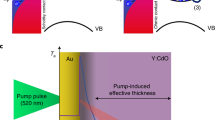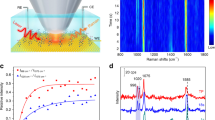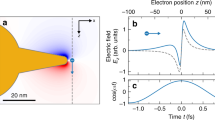Abstract
Surface plasmon polaritons are a central concept in nanoplasmonics and have been exploited to develop ultrasensitive chemical detection platforms, as well as imaging and spectroscopic techniques at the nanoscale. Surface plasmons can decay to form highly energetic (or hot) electrons in a process that is usually thought to be parasitic for applications, because it limits the lifetime and propagation length of surface plasmons and therefore has an adverse influence on the functionality of nanoplasmonic devices. Recently, however, it has been shown that hot electrons produced by surface plasmon decay can be harnessed to produce useful work in photodetection, catalysis and solar energy conversion. Nevertheless, the surface-plasmon-to-hot-electron conversion efficiency has been below 1% in all cases. Here we show that adiabatic focusing of surface plasmons on a Schottky diode-terminated tapered tip of nanoscale dimensions allows for a plasmon-to-hot-electron conversion efficiency of ∼30%. We further demonstrate that, with such high efficiency, hot electrons can be used for a new nanoscopy technique based on an atomic force microscopy set-up. We show that this hot-electron nanoscopy preserves the chemical sensitivity of the scanned surface and has a spatial resolution below 50 nm, with margins for improvement.
This is a preview of subscription content, access via your institution
Access options
Subscribe to this journal
Receive 12 print issues and online access
$259.00 per year
only $21.58 per issue
Buy this article
- Purchase on Springer Link
- Instant access to full article PDF
Prices may be subject to local taxes which are calculated during checkout






Similar content being viewed by others
References
Barnes, W. L. Surface plasmon-polariton length scales: a route to sub-wavelength optics. J. Opt. A 8, S87–S93 (2006).
Proietti Zaccaria, R. et al. Fully analytical description of adiabatic compression in dissipative polaritonic structures. Phys. Rev. B 86, 035410 (2012).
Shen, H., Guillot, N., Rouxel, J., de la Chapelle, M. L. & Toury, T. Optimized plasmonic nanostructures for improved sensing activities. Opt. Express 20, 21278–21290 (2012).
Guillot, N. et al. Surface enhanced Raman scattering optimization of gold nanocylinder arrays: influence of the localized surface plasmon resonance and excitation wavelength. Appl. Phys. Lett. 97, 023113 (2010).
Gucciardi, P. G. et al. Light depolarization induced by metallic tips in apertureless near-field optical microscopy and tip-enhanced Raman spectroscopy. Nanotechnology 19, 215702 (2008).
D'Andrea, C. et al. Optical nanoantennas for multiband surface-enhanced infrared and Raman spectroscopy. ACS Nano 7, 3522–3531 (2013).
Rauhut, N. et al. Antenna-enhanced photocurrent microscopy on single-walled carbon nanotubes at 30 nm resolution. ACS Nano 6, 6416–6421 (2012).
Goykhman, I., Desiatov, B., Khurgin, J., Shappir, J. & Levy, U. Locally oxidized silicon surface-plasmon Schottky detector for telecom regime. Nano Lett. 11, 2219–2224 (2011).
Knight, M. W., Sobhani, H., Nordlander, P. & Halas, N. J. Photodetection with active optical antennas. Science 332, 702–704 (2011).
Goykhman, I., Desiatov, B., Khurgin, J., Shappir, J. & Levy, U. Waveguide based compact silicon Schottky photodetector with enhanced responsivity in the telecom spectral band. Opt. Express 20, 28594–28602 (2012).
Mubeen, S. et al. An autonomous photosynthetic device in which all charge carriers derive from surface plasmons. Nature Nanotech. 8, 247–251 (2013).
De Angelis, F. et al. Breaking the diffusion limit with super-hydrophobic delivery of molecules to plasmonic nanofocusing SERS structures. Nature Photon. 5, 683–688 (2011).
De Angelis, F. et al. Nanoscale chemical mapping using three-dimensional adiabatic compression of surface plasmon polaritons. Nature Nanotech. 5, 67–72 (2010).
Babadjanyan, A. J., Margaryan, N. L. & Nerkararyan, K. V. Superfocusing of surface polaritons in the conical structure. J. Appl. Phys. 87, 3785–3788 (2000).
Stockman, M. I. Nanofocusing of optical energy in tapered plasmonic waveguides. Phys. Rev. Lett. 93, 137404 (2004).
Stockman, M. I. Erratum: nanofocusing of optical energy in tapered plasmonic waveguides [Phys. Rev. Lett. 93, 137404 (2004)]. Phys. Rev. Lett. 106, 019901 (2011).
Bao, W. et al. Mapping local charge recombination heterogeneity by multidimensional nanospectroscopic imaging. Science 338, 1317–1321 (2012).
Gramotnev, D. K., Vogel, M. W. & Stockman, M. I. Optimized nonadiabatic nanofocusing of plasmons by tapered metal rods. J. Appl. Phys. 104, 034311 (2008).
Aeschlimann, M. in Encyclopedia of Nanoscience and Nanotechnology (ed. Singh Nalwa, H.) Vol. 3, 29–40 (American Scientific, 2004).
Hasegawa, K., Nöckel, J. U. & Deutsch, M. Curvature-induced radiation of surface plasmon polaritons propagating around bends. Phys. Rev. A 75, 063816 (2007).
Wiener, A., Fernandez-Dominguez, A. I., Horsfield, A. P., Pendry, J. B. & Maier, S. A. Nonlocal effects in the nanofocusing performance of plasmonic tips. Nano Lett. 12, 3308–3314 (2012).
Melikyan, A. & Minassian, H. On surface plasmon damping in metallic nanoparticles. Appl. Phys. B 78, 453–455 (2004).
Sönnichsen, C. et al. Drastic reduction of plasmon damping in gold nanorods. Phys. Rev. Lett. 88, 077402 (2002).
Issa, N. A. & Guckenberger, R. Fluorescence near metal tips: the roles of energy transfer and surface plasmon polaritons. Opt. Express 15, 12131–12144 (2007).
Kats, M. A., Yu, N., Genevet, P., Gaburro, Z. & Capasso, F. Effect of radiation damping on the spectral response of plasmonic components. Opt. Express 19, 21748–21753 (2011).
Bharadwaj, P., Bouhelier, A. & Novotny, L. Electrical excitation of surface plasmons. Phys. Rev. Lett. 106, 226802 (2011).
Cabrini, S. et al. Focused ion beam lithography for two dimensional array structures for photonic applications. Microelectron. Eng. 78–79, 11–15 (2005).
De Angelis, F. et al. A hybrid plasmonic−photonic nanodevice for label-free detection of a few molecules. Nano Lett. 8, 2321–2327 (2008).
Donolato, C. Approximate analytical solution to the space charge problem in nanosized Schottky diodes. J. Appl. Phys. 95, 2184–2186 (2004).
Smit, G. D. J., Rogge, S. & Klapwijk, T. M. Scaling of nano-Schottky-diodes. Appl. Phys. Lett. 81, 3852–3854 (2002).
Sondheimer, E. H. The mean free path of electrons in metals. Adv. Phys. 50, 499–537 (2001).
Dalal, V. L. Simple model for internal photoemission J. Appl. Phys. 42, 2274–2279 (1971).
Simon, M. & Sze, K. K. N. Physics of Semiconductor Devices 3rd edn (Wiley-Interscience, 2006).
Card, H. C. & Rhoderick, E. H. Studies of tunnel MOS diodes I. Interface effects in silicon Schottky diodes. J. Phys. D 4, 1589–1601 (1971).
Hudait, M. K. & Krupanidhi, S. B. Doping dependence of the barrier height and ideality factor of Au/n-GaAs Schottky diodes at low temperatures. Physica B 307, 125–137 (2001).
Hardikar, S., Hudait, M. K., Modak, P., Krupanidhi, S. B. & Padha, N. Anomalous current transport in Au/low-doped n-GaAs Schottky barrier diodes at low temperatures. Appl. Phys. A 68, 49–55 (1999).
Lorenzoni, M., Giugni, A. & Torre, B. Oxidative and carbonaceous patterning of Si surface in an organic media by scanning probe lithography. Nano. Res. Lett. 8, 75 (2013).
Torrey, J. D. et al. Scanning probe direct-write of germanium nanostructures. Adv. Mater. 22, 4639–4642 (2010).
Canale, C., Torre, B., Ricci, D. & Braga, P. C. Recognizing and avoiding artifacts in atomic force microscopy imaging. Methods Mol. Biol. 736, 31–43 (2011).
Fowler, R. H. The analysis of photoelectric sensitivity curves for clean metals at various temperatures. Phys. Rev. 38, 45–56 (1931).
Palik, E. D. Handbook of Optical Constants of Solids. Part II (Academic, 1985).
Acknowledgements
The authors thank M. Lorenzoni for providing the patterned sample for hot-electron nanoimaging. The authors also thank S. Lupi for infrared absorption measurements, B. S. Ooi for helping with 980 nm measurements, and A. Fratalocchi for several useful discussions. E.D.F. acknowledges support from European Projects Nanoantenna (FP7 No. 241818, FOCUS FP7 No. 270483). M.I.S. acknowledges support from the Max Planck Society and the Deutsche Forschungsgemeinschaft Cluster of Excellence: Munich Center for Advanced Photonics (http://www.munich-photonics.de) and the Chemical Sciences, Biosciences and Geosciences Division (grant no. DE-FG02-01ER15213) of the Materials Sciences and Engineering Division of the Office of Basic Energy Sciences, Office of Science, US Department of Energy (grant no. DE-FG02-11ER46789).
Author information
Authors and Affiliations
Contributions
M.I.S. and E.D.F. conceived the adiabatic plasmonic hot-electron nanoscopy. A.G., A.T., B.T. and E.D.F designed the experiments and A.G., A.T. and B.T. performed the experiments and analysed the data. R.P.Z. and A.A. performed the numerical simulations. M.F. and M.M. realized the nanostructured devices. E.D.F. supervised the whole project. All authors contributed to the discussion of the results and to writing the manuscript.
Corresponding author
Ethics declarations
Competing interests
The authors declare no competing financial interests.
Supplementary information
Supplementary information
Supplementary Information (PDF 4395 kb)
Rights and permissions
About this article
Cite this article
Giugni, A., Torre, B., Toma, A. et al. Hot-electron nanoscopy using adiabatic compression of surface plasmons. Nature Nanotech 8, 845–852 (2013). https://doi.org/10.1038/nnano.2013.207
Received:
Accepted:
Published:
Issue Date:
DOI: https://doi.org/10.1038/nnano.2013.207
This article is cited by
-
Recent advances in tip-enhanced Raman spectroscopy probe designs
Nano Research (2023)
-
Volume fractional change of nano-particle for enhanced localization probability in surface plasmon polariton dispersion relation at AgSiO2-cesium atomic interface
Optical and Quantum Electronics (2023)
-
Ultra-confined Propagating Exciton–Plasmon Polaritons Enabled by Cavity-Free Strong Coupling: Beating Plasmonic Trade-Offs
Nanoscale Research Letters (2022)
-
Bimodal multilayer nanostructure based on vanadium dioxide phase transition: absorber and hot electron photodetector
Applied Physics A (2022)
-
Infrared driven hot electron generation and transfer from non-noble metal plasmonic nanocrystals
Nature Communications (2020)



